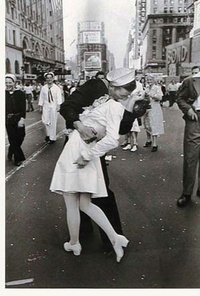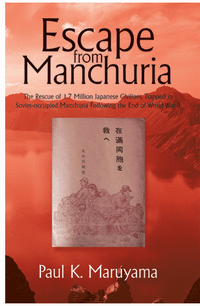Emperor Hirohito of Japan gave an unprecedented radio address at noon 65 years ago today, on August 15, 1945, to announce that Japan would surrender unconditionally to the United States and the allied powers.
The Victory over Japan Day, or VJ Day, officially ended World War II on September 2 1945 when Japan signed the documents of surrender aboard the USS Missouri, and ushered in an era of incredible prosperity for Americans, even though more wars, in Korea, Vietnam, Iraq and now Afghanistan, would prevent peace in the decades to come.
The end of WWII is justly celebrated as the close to a violent, though heroic, chapter in our history. But our perspective often blocks empathy for the perspective of the vanquished, as with our ignorance of August 6 and 9, 1945, the anniversary of the atomic bombs dropped on Hiroshima and Nagasaki that led to the August 15 announcement by Emperor Hirohito urging Japanese to “bear the unbearable” and accept the country’s surrender.
Except for the elderly veterans and American civilians who served in the Occupation Forces under General Douglas MacArthur, there isn’t much awareness of what Japan was like in the months and years after the war. The Occupation lasted until 1952, thr brink of the Koraen war.
But, I would guess that many Americans don’t have any awareness of Japan until the 1964 Olympics, which were held in Tokyo, and which heralded the arrival of Japan as a world power that, by the 1980s, rivaled the U.S. economy.
That’s why I’m so fascinated by the postwar era in Japan—it’s a hazy, forgotten time. I was born during that era, in Tokyo in 1957, and lived in two worlds—attending school on U.S. military bases and living in Japanese civilian neighborhoods until the mid-1960s, when my family moved Stateside.
For Japanese, the end of the war is remembered vividly for the atomic bombings and the utter poverty the country was left in by its military leadership. Even before the atomic bombs, its majors cities had been firebombed for months by U.S. bombers. In one night of bombings in Tokyo, almost as many people were killed as by the atomic bomb on Hiroshima, and great swaths of Tokyo had been leveled.
It’s hard to imagine the scale of death and destruction that modern warfare can inflict on a country and its people. That’s why, in spite of a stubborn nationalistic streak that leads to some Japanese still thinking like the country did in the 1930s and ’40s, and claiming atrocities such as the Nanjing Massacre (where hundreds of thousands of civilians were reportedly murdered by invading Japanese troops) never happened, most Japanese are strongly anti-war and against nuclear weapons. They don’t want the world to forget.
But there’s a forgotten history, even for the Japanese.
There were 1.7 million Japanese citizens trapped in Manchuria, in northern China, when the war ended. They had settled in Manchukuo, a puppet state created in Manchuria when Japan invaded China in 1931. Japanese were urged to go to Manchuria to claim the land and farm, and help Japan’s war effort with steelworks, mines and factories as the country expanded its imperial march through the rest of Asia.
Because of propaganda from the Japanese government, these settlers in Manchuria didn’t know that Japan had been losing the war for several years, and was so desperate the country was conscripting young boys to fly planes as weapons on suicide missions, the Kamikaze.
When the war suddenly ended, the Japanese found themselves stranded and facing hostility from the Chinese and a new foe, Russia, who had joined the Allied forces and declared war against Japan just days before the surrender so they could claim a share of the postwar spoils. On August 8, Russia invaded Manchuria and began occupying the region, clashing with the remaining and by then, much-weakened Japanese Kwantung Army.
In the chaos of Japan in the months following the surrender and the installation of MacArthur’s Occupation forces, the Japanese in Manchuria were largely forgotten. Their businesses were shut down, their bank accounts seized. Attacks against Japanese including rapes and murders were common. Hundreds died of malnutrition and disease every day.
But three men who were settlers in Manchuria undertook a dangerous plan to escape and make their way back to Japan to urge the government—and its rulers, the Occupation forces—to repatriate the trapped colonists.
The story of the three men, Kunio Maruyama, Hachiro Shinpo and Masamichi Musashi, and their daring adventure and tireless efforts to tell Japanese about the situation in Manchuria has been chronicled in a new book, “Escape from Manchuria,” written by Paul Maruyama, the son of Kunio Maruyama.
Paul was born in Tokyo in 1941, and was just a child during his family’s ordeal in Manchuria. When his father escaped with his two partners to try and rescue the stranded Japanese, he and his two brothers and mother were left in the care of the Catholic Maryknoll Mission, and weren’t reunited with his father for almost a year—they were among the last Japanese to leave Manchuria.
Paul Maruyama is a retired Air Force Colonel who taught Japanese and Judo at the Air Force Academy and still teaches Japanese at Colorado College. He was a member of the U.S. Judo team (along with Congressman-to-be Ben Nighthorse Campbell) that debuted the martial art as an Olympic sport at the 1964 Tokyo Olympics. He and his wife LaRae live just north of Colorado Springs, and I’ve known them for years. His father was a Japanese educated in the U.S., and his mother was a Japanese American who met his father in the U.S.
Paul wrote the book with help from books written in Japanese by his father and Musashi, which told their story. But the tale is little-remembered today in Japan and completely unknown here in the U.S. Maruyama wanted to give the story a fresh telling, and hopefully get official Japanese recognition for the exploits of his father and the other two men.
Maruyama isn’t a writer by trade, so the book could have benefited from the guiding hand of an editor. The narrative is powerful, but the language sometimes so straightforward that it’s almost dry. Maruyama also restates facts a little too often—“1.7 million” Japanese was mentioned so many times I was ready to scream if I saw the number again.
And, though he acknowledges that there was animosity from the Chinese for the stranded Japanese because of the way Chinese were treated by the Japanese invaders, I wished there had been a way to more clearly explain for readers the level of atrocities the Japanese—especially the military—committed in Manchuria, in China and throughout Asia. That would more vividly explain the fury that faced these settlers once the war ended and their subjects became their masters.
But these criticism are nits. Anyone interested in 20th century Asian history should read “Escape from Manchuria” to learn about the three men’s heroism, and wonder why their efforts are so forgotten today, even in Japan. At the time, when they escaped and arrived in Japan, they were the toast of the national media, and became in-demand speakers as well as spokesmen for anyone who had families and friends not just in Manchuria, but elsewhere in Asia, waiting to be repatriated.
Because of the care they took to prepare for their escape (they got letters of introduction from Japanese leaders in Manchuria as well as from the American head of the Catholic Church in China), the three men received at the highest levels of both the Japanese government and the top brass at MacArthur’s headquarters. They even got to meet MacArthur at GHQ.
Their tireless campaign to bring attention to the plight of the Japanese in Manchuria ultimately led to the evacuation of the stranded citizens and their repatriation to Japan.
The book is an important historical document, but it may not be a big seller here. I understand there are plans to publish it in Japanese, though, and I hope it’ll be a huge bestseller there.
It’ll strike a chord in Japanese readers that will remind them of an important historic episode without being unnecessarily nationalistic (it’s more of a human story than a political one), and it has all the elements of a great cinematic treatment: Pathos, suspense, action, danger, heroism, hope and tenacity and ultimately, a happy ending.
Read my Nikkei View column from 2003 about historian John Dower’s excellent Pulitzer Prize-winning book about Japan in the immediate years after WWII, Embracing Defeat.
*This article was originally published in NIKKEI VIEW: The Asian American Blog on August 15, 2010.
© 2010 Gil Asakawa









